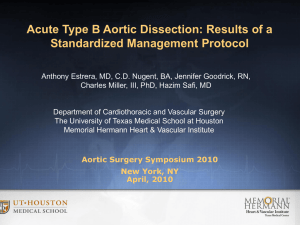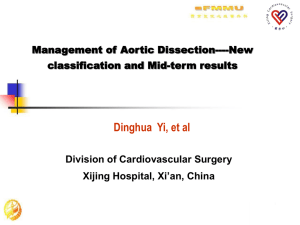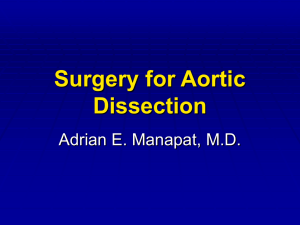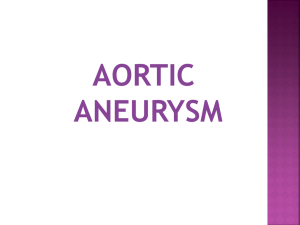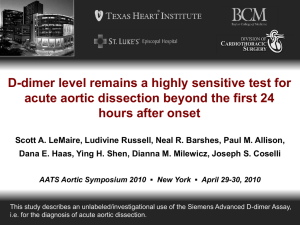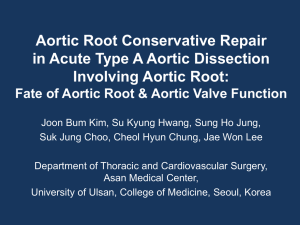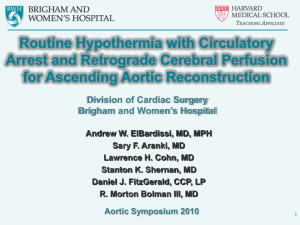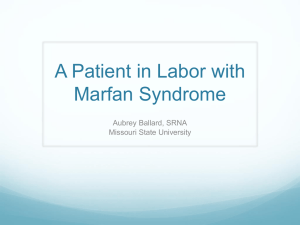Management of acute type b aortic dissection
advertisement
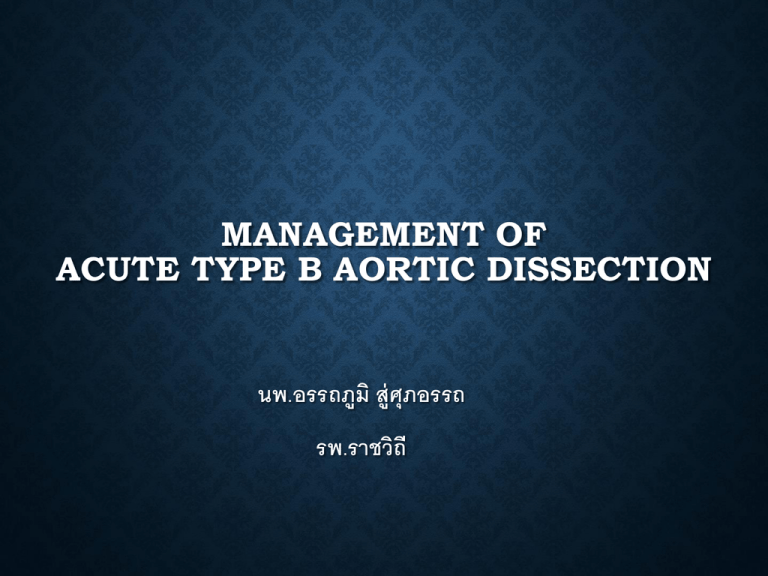
MANAGEMENT OF ACUTE TYPE B AORTIC DISSECTION นพ.อรรถภูมิ สู่ศุภอรรถ รพ.ราชวิถี COMPLICATIONS IN ACUTE TYPE B AORTIC DISSECTION • No uniform criteria to define “complicated” • 15-20% of cases • Impending rupture • Malperfusion syndrome (10%) • Hemodynamic instability (15%) • Refractory hypertension MALPERFUSION SYNDROMES • About 10% of patients with type B aortic dissection 1. Dynamic malperfusion caused by branch vessel occlusion of the true lumen by the pressurized false lumens 2. Static malperfusion caused by propagation of the dissection into branch vessel ostia with distal vessel occlusion MALPERFUSION SYNDROMES • Mesenteric ischemia • abdominal pain, nausea, and diarrhea • associated with an increase in laboratory markers (bilirubin, amylases, hepatic, and intestinal enzymes). • Highly devastating and has a major impact on early mortality • Lower limb ischemia • Relatively benign and surgical intervention should be performed in symptomatic patient. • Spinal cord ischemia • paraparesis or paraplegia STRATEGY Therapeutic Aim • To restore the perfusion of the organs • To stop/limit the dissecting process to protect the organs • Central Aortic Repair • Aortic Replacement • Fenestration • Endograft • Re-entry fenestration • Peripheral repair • Graft Bypass • Stenting • A 59-year-old male with history of hypertension and COPD presented with abdominal pain, painful, pulseless right lower extremity TL TL Celiac a. TL TL Rt CIA Rt RA Lt RA FL STENT-GRAFT PLACEMENT IVUS/ TEE superior to angiography for identifying • Primary and distal reentry tears • Documenting guidewire position in the true lumen • Assessing seal zones • Detecting endoleaks • assessment of the ascending aorta to be mandatory at the conclusion of each TEVAR case to assess for retrograde ascending aortic dissection Circulation. 2005;112:I260-4. STENT PLACEMENT • Uncovered stents improve flow 1. inadequate relief of dynamic obstruction after surgery 2. static obstruction of abdominal aortic branch vessels, which is typically unaffected by proximal aortic stentgraft treatment and fenestration. IMPENDING RUPTURE/RUPTURE • Persistent pain despite good blood pressure control • Aortic dissection with persistent uncontrolled hypertension • Evidence of dissection progression despite optimal medical management. • An increase in perioaortic hematoma and hemorrhagic pleural effusion in 2 subsequent CT examinations • Requires sealing off the primary tear as well as the site of the leak • Frequently necessitates paving the entire thoracic aorta when the site of the leak is unclear. J Am Coll Cardiol Intv 2008;1:395– 402. Circulation 2010;122:1283–9. REFRACTORY HYPERTENSION • International Registry of Acute Aortic Dissection (IRAD) trial data showed that in-hospital mortality after medical management was significantly increased in average-risk patients with type B aortic dissection under medical therapy with refractory hypertension/pain compared with those without these features (35.6% vs. 1.5%; p 0.0003) Circulation 2010;122:1283–9. OPEN SURGERY UNCOMPLICATED ACUTE TYPE B AORTIC DISSECTION • Medical management • Anti-impulse therapy • uncomplicated dissection • lack of appropriate facilities • presence of comorbidities or morphology that made open surgery or TEVAR not feasible • IRAD: 3-yr survival = 78% • Late aortic-related complications= 25-50% PROPHYLACTIC TEVAR? • Thrombosed false lumen predicts lower event rates after type B dissection • Randomized comparison of strategies for type B aortic dissection: the INvestigation of STEnt Grafts in Aortic Dissection (INSTEAD) trial • Found no difference in the primary end point of all-cause mortality at 2 years • Thoracic false lumen thrombosis, TEVAR> Medical Mx :91.3%VS 19.4% (P < .001) • high rate of aorta-related deaths in the TEVAR group resulting from periprocedural technical complications Circulation. 1993;87:1604-15. Circulation. 2009;120:2519-28. HIGH-RISK FEATURES OF UNCOMPLICATED TYPE B DISSECTION • Initial aortic diameter ≥ 4.0 cm with patent false lumen *,€,ɸ • Initial false lumen diameter ≥ 22 mm in proximal DTA ∞ • IMH with PAU in proximal DTA *,ɸ * Eur J Vasc Endovasc Surg.2006;32:349-55. € J Thorac Cardiovasc Surg. 2007;134:1163-70. ɸ Circulation. 2010;122: S74-80. ∞J Am Coll Cardiol. 2007;50:799-804. LONG-TERM MANAGEMENT • Specific predictors of follow-up mortality include • Female gender • Prior aortic aneurysm • Atherosclerosis • Pleural effusion • In-hospital acute renal failure • Hypotension or shock • β-blockade & blood pressure control • IRAD: calcium channel blockers at discharge was associated with improved long-term survival selectively in medically treated type B dissection patients • >1/3 of patients will require surgery for aortic-related complications within 5 years of the initial dissection • Serial imaging at 1, 3, 6, and 12 months after discharge, and annually OUTCOME DATA FROM MEDICAL THERAPY • Early mortality rate = 6.4% (95% CI: 5.1% to 7.9%) • Stroke = 4.2% (95% CI:2.3% to 7.4%) • spinal cord ischemia = 5.3% (95% CI: 3.4% to 8.4%) • 5-year survival rates ranged from 70.2% to 89% • Aortic adverse event freedom (including aortic death, rupture, new dissection, enlargement, reintervention) ranged from 75% to 88.5% at 5 years, but there were variable event definitions among studies OUTCOME DATA FROM TEVAR • in most of the papers, indication for TEVAR was complicated acute type B dissection • criteria for defining complicated were variable • Early mortality rate =10.2% (95%CI: 9.0% to 11.6%) • Stroke = 4.9% (95% CI: 4.0% to6.0%) • Spinal cord ischemia = 4.2.% (95% CI: 3.3% to 5.2%) • 5-year survival rates ranged from 56.3% to 87% • Freedom from aortic events ranged from 45% to 77% at 5 years. OUTCOME DATA FROM OPEN SURGERY • Early mortality rate = 17.5% (95% CI: 15.6% to 19.6%) • Stroke = 5.9% (95% CI: 4.8% to 7.3%) • Spinal cord ischemia = 3.3%(95% CI: 2.4% to 4.5%) • 5-year survival rates ranged from 44% to 64.8% • Freedom from aortic events ranged from 58.7% to 68% at 5 years. MEDICAL THERAPY VS TEVAR AND OPEN SURGERY VERSUS TEVAR • invalidated by unbalanced populations (unmatched illness conditions and rates of complicated vs. uncomplicated cases of patients assigned to each treatment). • Complicated cases Open Sx, TEVAR • uncomplicated cases Medical treatment COMPARISON OF EARLY (30 DAYS/IN-HOSPITAL) OUTCOMES WITH MEDICAL THERAPY AND TEVAR IN ACUTE TYPE B AORTIC DISSECTIONS SUBACUTE TYPE B AORTIC DISSECTION • Very limited outcome data • INSTEAD (Investigation of Stent Grafts in Aortic Dissection) trial • Primary success rate = 95.7% • Early mortality = 2.8% • Stroke rate =1.4% • Spinal ischemia= 2.9% • Required secondary procedures = 18% VIRTUE (VALIANT THORACIC STENT GRAFT EVALUATION FOR THE TREATMENT OF DESCENDING THORACIC AORTIC DISSECTIONS- POST MARKETING SURVEILLANCE REGISTRY) REGISTRY • 24 patients with complicated subacute type B aortic dissections treated with TEVAR • Primary procedural success rate= 100% • Early mortality rate =1.8% • Late deaths = 0% • Strokes or cases of spinal cord ischemia = 0% • Negative prognosis in the subacute phase • Change in aortic morphology (expanding diameter 4 mm, new onset of periaortic hematoma, and/or pleural hemorrhagic effusion) • Refractory hypertension • Recurrent thoracic pain • Malperfusion SUBACUTE TYPE B AORTIC DISSECTION
